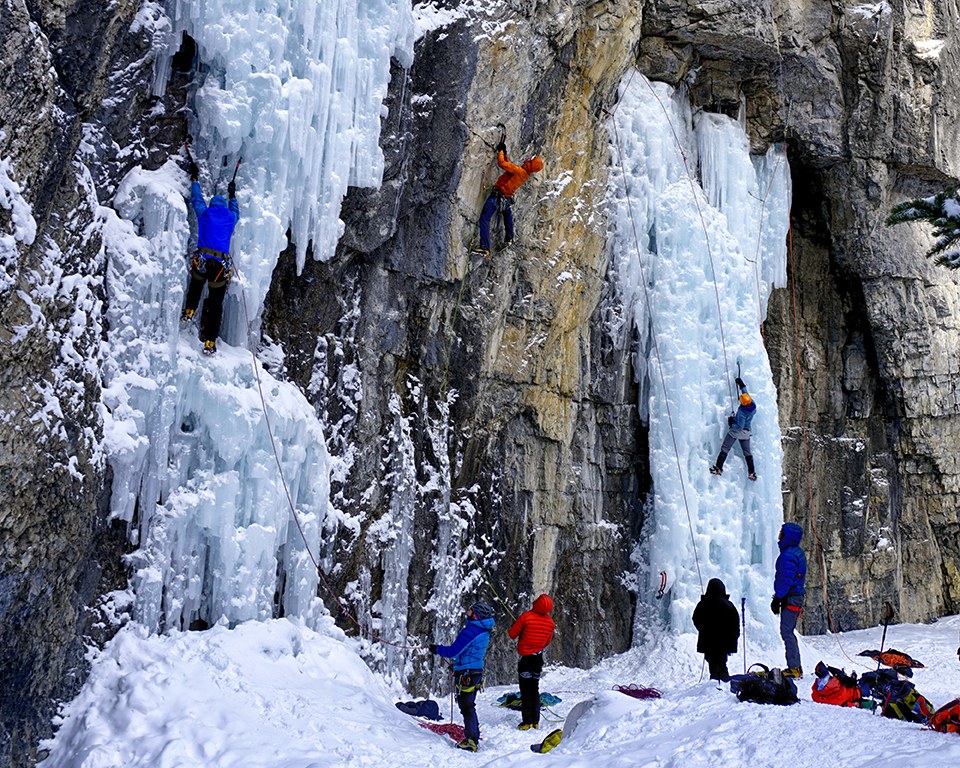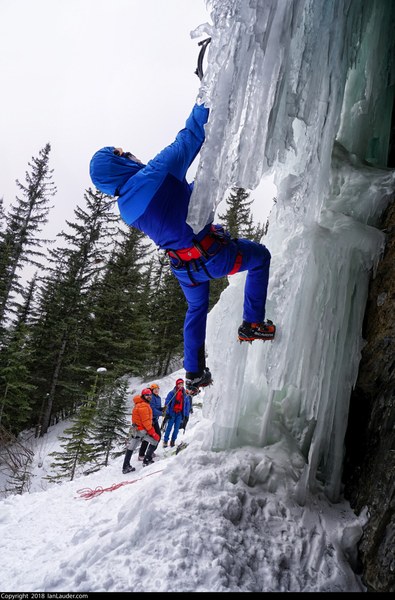
In mid-2016, The Mountaineers Board of Directors voted to allocate funds to begin an initiative called Progressive Climbing Education (PCE). The goal was to dedicate resources to advance the goals and initiatives of our passionate volunteers.
Done well, these strategic investments will make our suite of volunteer-led climbing programs more fun for volunteers to run, more attractive to new climbers (especially those coming out of the gym), more enticing to prospective volunteers, and more comprehensive to include advanced courses and clinics for our highly-skilled leaders and students.
The Alpine Ambassadors program is one piece of the organization-wide PCE initiative. Through a series of structured, educational field trips with support from peers, volunteers, and professional guides, the Alpine Ambassadors program will help emerging and current leaders develop skills to benefit the greater Mountaineers community. This group, comprised of leaders from all branches with climbing programs, will soon be seeking applicants for the next trip. If you're a volunteer who is excited about advancing your skills and promoting the spirit of mentorship in The Mountaineers, we encourage you to apply. We strongly encourage women, people of color, and LGBTQ climbers to apply. Learn more at www.mountaineers.org/pceblog.
- Becca Polglase, Education Director
I’d always been taught that the first two rules of ice climbing on lead are 1) don’t fall and 2) don’t fall. These days I still hope to follow those rules 100% of the time, but now I have many more risk-mitigating tools in my bag. Take, for example, belaying off a direct anchor rather than your harness: in some situations this technique can improve your safety system. This is one of many tools I picked up through a new Mountaineers program called Alpine Ambassadors.
Championed by world-renowned alpinist, Mountaineers Books author, and Mountaineers Board Member Steve Swenson, Alpine Ambassadors was launched in 2018 as a way to provide continuing education for experienced Mountaineers leaders. For the program’s inaugural journey, The Mountaineers invited volunteer leaders to apply for an ice climbing skills development trip in Canmore, Alberta.
I was thrilled to be one of the 18 Mountaineers selected.
In Canmore, I began realizing how much I had to learn. After top roping up a WI-5 route (considered a difficult climb on seasonal water ice), I came down feeling solid. Thanks to the mentorship I’d been getting all week, my technique and pump management was fine. For practice on the way up, I paused to mime placing gear. However, when I started explaining to my instructor how and where I would have placed protection, I learned that my assessment of the quality of ice was appallingly bad. What I thought was decent ice was actually WI-5 R/X – a poorly frozen pillar on which a fall would be extremely dangerous.
This was especially surprising because I’d spent the previous day on good ice under the tutelage of legendary climber Jim Elzinga. To me, the ice felt the same on both days, and it blew my mind to realize how difficult it can be to judge variable ice quality. One day you’re dancing up a thin pillar, and the next you’re climbing near your limit and unknowingly placing protection in awful ice. Mentorship is humbling and powerful, and provides an invaluable learning experience.
 An Alpine Ambassador climbing in Canmore. Credit: IanLauder.com.
An Alpine Ambassador climbing in Canmore. Credit: IanLauder.com.
A new path to progression
As an active and motivated member of The Mountaineers for several years, it wasn’t long before I ran out of climbing programs that would push my personal progression. The programs offered by The Mountaineers are great, but once you complete the Intermediate Climbing Course and have a baseline skill proficiency, the mentee or student role traditionally shifts to that of mentor.
As a result, if you want to grow and develop your personal climbing skills, you have to drive that process yourself. All too often this means members either stagnate or look outside the organization for new partners and challenges, leading to a noticeable dilution of skilled volunteers and leaders running our programs. The Alpine Ambassadors program seeks to address all of these hurdles within our organization’s climbing programs.
To be selected for the Canmore trip, applicants needed to demonstrate an impressive history of volunteerism, a solid foundation of mountaineering skills, and a strong potential for continued leadership.
In Canmore, The Mountaineers hired certified guides and recruited highly skilled volunteers to take us out in small groups each day. The goal of the trip was twofold: to help us improve as Mountaineers leaders and help us achieve our personal goals. Over the course of a week, we developed more efficient movement in steep terrain, became more proficient at judging ice quality and finding adequate protection, and learned the best practices for managing ropes, anchors, and transitions at belays in multi-pitch environments. Furthermore, the program directors organized evening programs, gatherings, and meetings to outline goals, keep the psych high, and introduce us to bigger and better adventures available as a result of our training.
To Squamish and beyond
For the second phase of the program, new and returning Alpine Ambassadors headed to Squamish, British Columbia in August 2018. This excursion focused on developing the high-level rock climbing skills of Mountaineers leaders. Squamish is a world-class climbing destination, and once again the mentorship opportunities exceeded expectations.
Similar to the Canmore trip, we honed our techniques, allowing us to climb more efficiently, smoothly, and safely. The week’s clinics were geared toward improving existing Mountaineers programs and courses with respect to curriculum, and we learned methods for teaching material to match various learning styles. We also learned about managing group dynamics in various situations.
At the end of each day, we debriefed in camp below the powerful presence of a huge granite dome called The Chief. Our meetings gave us an outlet to stay organized and review each participant’s goals for the trip. They also allowed us to form new cross-branch connections, friendships, and belaytionships.
After Squamish, nearly everyone raved about bumping up their lead climbing comfort zone by at least one grade. The same was true for Canmore. On both trips, it was a tremendous honor to climb with and learn from so many prolific first ascensionists, high altitude expedition gurus, and humble recipients of the exceptional Piolet d’Or award. The mentorship was top-notch, the comradery created across branches was great, and the ice and rock were incredible! And all of this came from an opportunity generously provided by The Mountaineers.
Looking ahead
Personally, I am really looking forward to building lasting climbing partnerships, climbing cool but less frequented areas, and breaking through my current skills ceiling. It’s a joy to be part of and give back to an organization that funds initiatives to protect and maintain public lands, provides scholarship programs for underprivileged youth, centralizes community gatherings at fantastic program centers and climbing destinations, maintains one of the largest nonprofit publishers for mountaineering literature (Mountaineers Books), offers generous incident guidance and support for sanctioned activities, pursues quality training for maintaining best practices, and now executes a strategic vision to offer growth opportunities for volunteers through programs like Alpine Ambassadors.
I feel incredibly lucky to be an Alpine Ambassador, and I’m excited to see what new programs and climbs are offered through The Mountaineers as a result of our new wave of volunteer leaders. The proverbial next generation of alpinists will be in better hands to take over the reins and lead the club in a positive direction for years to come.
I’d also like to see this program broaden the horizons of Mountaineers climbs, especially more challenging routes. There is so much potential for exploration and development here in the Western United States and Canada. I hope this network of Alpine Ambassadors connects me with partners or crews for forays into new local zones – and maybe even an international trip to Baffin Island, Patagonia, or the Trango Towers. Alpine Ambassadors inspires me to continue down the path of progression, both as a mentor and as a mentee.
This article originally appeared in our Winter 2019 issue of Mountaineer Magazine. To view the original article in magazine form and read more stories from our publication, visit our magazine archive.
 Kyle Breakey
Kyle Breakey